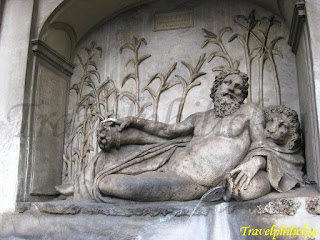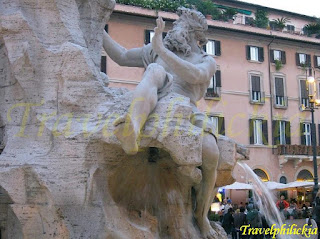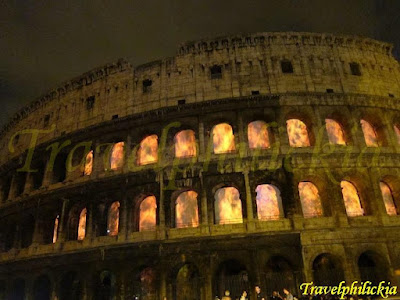Took a morning train from Neuchâtel at 0734 hours and we reached Genèva Airport at 0847 hours. Bought a SBB train ticket at CHF 44 for both ways.
Alitalia flight
Glad that flight F7 1121, operated by Alitalia, took off on time without any delays. Amazed that only a pack of crackers and a drink were served on flight (left photo below). The flight landed on Rome-Fiumicino Airport at about 12 noon. Similar to most budget carriers, passengers would need to walk towards the airport terminal without the use of any passenger boarding bridge (right photo below).

 After custom clearance, we then took Airport Shuttle Express to our B&B. Got our keys from the agent who waited for us at the B&B. After some wash-up, we were ready to explore Rome.
After custom clearance, we then took Airport Shuttle Express to our B&B. Got our keys from the agent who waited for us at the B&B. After some wash-up, we were ready to explore Rome.Simple Lunch
While walking along 'Via dei Serpenti', we saw a Pizzeria (left photo below). Therefore, decided to have a simple lunch there. Ordered four slides of pizza (right photo below), and interestingly it was sold by weight at EUR 14 per kg. After some weighing, the cost for my simple lunch was EUR 3.14.

 Rome
RomeRome, or Roma in Italian, is the capital and most populous metropolitan city in Italy. Rome's history spans over 28 centuries and became first in one of the major centres of the Renaissance, and then the birthplace of both the Baroque style and Neoclassicism.
 |
The historic centre of Rome is listed by UNESCO as World Heritage Site in 1980. It is further extended in 1990 to include some of the major monuments of antiquity. |
After 15-mins walk, we reached the first sight. The Quattro Fontane, or the Four Fountains in English, were installed between 1588 and 1593 and located at the intersection of Via delle Quattro Fontane and Via del Quirinale.
The figure in front of an oak-tree is said to represent the River Tiber (left photo below). The second fountain represents River Aniene (right photo below), a tributary of the Tiber, which provided most of Roman aqueducts with water.


The other two fountains of female figures believed to represent the Goddess Diana - symbol of Chastity (left photo below) and Goddess Juno- symbol of Strength (right photo below).


Quirinal Palace
The Quirinal Palace, or Palazzo del Quirinale in Italian, is one of the three current official residences of the President of the Italian Republic (left photo below). This palace has also served as residence for thirty Popes, four Kings of Italy and twelve Presidents of the Italian Republic. Therefore, it is not unusual to see guards standing in their post outside this palace (right photo below).


This palace, built in 1583, extends for an area of 110,500-square meters and is the tenth largest palace in the world in terms of area. For comparison, it is some twenty times bigger than of the White House.
The Quirinal Obelisk, in front of the Quirinal Palace, is a 15-meters tall obelisk with no inscription engraved (photos below). This obelisk, together with Esquiline obelisk, were probably quarried by the Romans in late first century, and erected at the entrance of the Great Tomb of Emperor Augustus in Rome. This obelisk, when rediscovered in 1781, was fragmented in three pieces. After 4-years of restoration, this obelisk was erected at the current site by Pope Pius VI in 1786.


Trevi Fountain
The Trevi Fountain, or Fontana di Trevi in Italian, is an 18th century fountain standing at 26.3-meters high and 49.15-meters wide. It is the largest Baroque fountain in the city and one of the most famous fountains in the world (photo below).
In the centre underneath the arch stands the statue of the nautical god Neptune (left photo below). The two statues in the niches next to Neptune are Salubrity and Abundance (right photo below).


The fountain depicts Neptune being pulled to the sea on his shell-shaped chariot by two winged horses and tritons (young gods of the sea). One of the horses is calm and obedient (left photo below), the other is boisterous (right photo below). They symbolize the changing tides of the sea.

 It is tradition to throw a coin into the fountain by keeping eyes closed and throw the coin into the water over left shoulder using right hand. According to legend, the person who throws the coin will one day return to Rome.
It is tradition to throw a coin into the fountain by keeping eyes closed and throw the coin into the water over left shoulder using right hand. According to legend, the person who throws the coin will one day return to Rome.Temple of Hadrian
The Temple of Hadrian is an ancient Roman (2nd-century) structure with only one cella wall and eleven Corinthian columns from the external colonnade survived (photos below). These remains of the temple have been incorporated into a papal palace in 1695.


The Pantheon
The Pantheon is a former Roman temple that begun construction in 27 B.C., and later a Catholic church since 609 A.D (photos below).


Pantheon is remarkable for its size that its dome was the largest built until modern times, measuring about 43-meters in diameter and rising to a height of 22-meters above its base. There is no external evidence of brick arch to support inside the dome, except in the lowest part, and the exact method of construction has never been determined. The porch is conventional in design, but the body of the building, an immense circular space lit solely by the light that floods through the 8-metres "eye", or oculus, opening at the centre of the dome, was revolutionary (photos below).


The Pantheon is often crowded with visitors (photos below); especially between 1000 hours and 1400 hours with tourist groups arriving.


There are eight separate recessed spaces around the Pantheon:
- Four of the recesses are chapels dedicated to St. Joseph (left photo below), the Madonna of Clemency, the Crucifixion, and the Annunciation (right photo below).
- Three of the remaining are tombs: two are Kings of the unified Italy, including Victor Emmanuel II (left photo below) known as the 'Father of the Nation', and the other Umberto I (right photo below) whose tomb is often guarded by volunteers.
- The last tomb is the final resting place of the great artist Raphael (left photo below).
- The final recess is the high altar (right photo below). It's not unusual for Mass to be celebrated amidst the throng of visitors around the recess containing the sumptuous high altar.
| ✍ Update: |
|---|
| Visitors to Pantheon will have to pay a EUR 5 entrance fee from 03 July 2023. |
Piazza della Rotonda
The Piazza della Rotonda is a piazza (city square) on the south side of the Pantheon. In the centre of the piazza is a fountain, the Fontana del Pantheon, surmounted by an Egyptian obelisk, known as the 'Macuteo Obelisk' (photos below).


This obelisk, 6.34-meters tall, was originally erected in front of the Temple of Ra in Heliopolis, by Ramses II, as the pair of another obelisk which is now in Celimontana. In 14th century, this obelisk was found underground near to Piazza di San Macuto. Hence it is called "Macuteo Obelisk". Finally, in 18th century, Pope Clemens XI decided to move the obelisk to Piazza della Rotonda.
Column of Marcus Aurelius
The column of Marcus Aurelius, or Colonna di Marco Aurelio in Italian, is a Roman victory column in Piazza Colonna (left photo below). It is a Doric column modelled on Trajan's Column featuring a spiral relief and was built in honour of Roman Emperor Marcus Aurelius (right photo below).


The spiral picture relief tells the story of Marcus Aurelius's Danubian or Marcomannic wars, waged by him from 166 A.D. to his death in 180 A.D. (photos below).

 Montecitorio Palace
Montecitorio PalaceMontecitorio Palace, or Palazzo Montecitorio in Italian, is a palace for the seat of the Italian Chamber of Deputies (left photo below). The palace was constructed in 1653 when Pope Innocent X commissioned Gian Lorenzo Bernini a residence for the Ludovisi family. The excavated obelisk of the Solarium Augusti, now known as the 'Obelisk of Montecitorio', was installed in front of the palace by Pius VI in 1789 (right photo below).


With the Unification of Italy in 1861 and the transfer of the capital to Rome in 1870, Montecitorio was seized by the Italian government and chosen as the seat of the Chamber of Deputies.
Giolitti
Decided to refresh ourselves in this Giolitti store located at 'via Uffici del Vicario' (left photo below). Giolitti is a well-known café and pastry shop, and reportedly to be the oldest ice cream parlor in Rome founded in 1890. Long queue already formed up inside the shop (right photo below).

 Customers need to pay at the counter first before ordering. From the many choices of gelato (left photo below), I selected Banana and Pistachio flavors (right photo below). Each gelato cone with two flavors cost EUR 2.50.
Customers need to pay at the counter first before ordering. From the many choices of gelato (left photo below), I selected Banana and Pistachio flavors (right photo below). Each gelato cone with two flavors cost EUR 2.50.

 Santa Maria sopra Minerva
Santa Maria sopra MinervaSanta Maria sopra Minerva is one of the major churches of the Roman Catholic Order of Preachers (left photo below) located in Piazza della Minerva which is just one block behind the Pantheon. One of the most curious monuments in Rome is the Pulcino della Minerva in front of the church. It is a statue of an elephant as the supporting base for the Egyptian obelisk (right photo below). It is the shortest of the eleven Egyptian obelisk in Rome.

 Largo di Torre Argentina
Largo di Torre ArgentinaLargo di Torre Argentina is a square brought to light by archaeological investigation on the presence of a holy area dating to the Republican era. This area consists of the remains of four Roman Republican temples, built between 101 B.C. to 2 B.C., and part of Pompey's Theatre (left photo below).
This square is also the location for Torre Argentina Cat Sanctuary, founded in 1993, where cats roam freely on this ground (right photo below).

 Campo de' Fiori
Campo de' FioriCampo de' Fiori, or Field of Flowers in English, is a rectangular square south of Piazza Navona (left photo below). In the centre of the square stands the statue of Giordano Bruno (right photo below), where this philosopher was burnt alive in 1600 by the Holy Office. A monument was dedicated to him in 1889 as he stands defiantly facing the Vatican and was regarded in the first days of a reunited Italy as a martyr to freedom of thought.


Campo de' Fiori is one of the lively markets well known for its flowers (photos below) and fruits/vegetable during the day, and a meeting place after sunsets for its restaurants and bars.

 Piazza Navona
Piazza NavonaPiazza Navona is a public open space since the 15th century and now famous for its fountains.
Fontana del Moro
- Fontana del Moro, or Moor Fountain in English, is located at the southern end of Piazza Navona. It represents a Moor, or African (perhaps originally meant to be Neptune), standing in a conch shell, wrestling with a dolphin, surrounded by four Tritons (left photo below).
Fontana del Nettuno
- Fontana del Nettuno, or Fountain of Naptune in English, is located at the northern end of Piazza Navona. Neptune is the central figure, representing the god of the sea with the trident that defends himself from an octopus clinging to its legs. At the semi-circular sides are aquatic animals and nereids, sea horses led by children, sirens fighting with sea, monsters and winged cherubs playing with dolphins (right photo below).


- Sant'Agnese in Agone is a 17th century Baroque church facing the Piazza Navona (photos below).

The cupola is frescoed with the Apotheosis of Saint Agnes (left photo below) and the Main altar is adorned with the marble relief of The Holy Family (right photo below).


- Fontana dei Quattro Fiumi, or Fountain of the Four Rivers in English, is located in the centre of Piazza Navona. The base of the fountain is a basin from the centre of which travertine rocks rise to support four river gods and above them, a copy of an Egyptian obelisk surmounted with the Pamphili family emblem of a dove with an olive twig (photos below).


Collectively, they represent four major rivers of the four continents through which papal authority had spread: the Ganges representing Asia (left photo below), the Río de la Plata representing the Americas (right photo below), the Danube representing Europe (bottom left photo), and the Nile representing Africa (bottom right photo).



 At night, these sculptures looked even more charming (photos below).
At night, these sculptures looked even more charming (photos below).

Dinner at Piazza Navona
As the sky turned dark, we decided to have dinner at one of the restaurants at Piazza Navona (photos below).

 Ordered a Penne alla carbonara at EUR 12 for myself (left photo below) and shared a dessert at EUR 8 (right photo below). Taste was good and authentic of Italian food.
Ordered a Penne alla carbonara at EUR 12 for myself (left photo below) and shared a dessert at EUR 8 (right photo below). Taste was good and authentic of Italian food. 

Palazzo Madama
While walking back, we saw this Palazzo Madama (left photo below) which is the seat of the Senate of the Italian Republic since 1871.
Galleria Alberto Sordi
The Galleria Alberto Sordi (right photo below) is a shopping arcade inaugurated in 1922.


Fontana del Tritone
Fontana del Tritone, or Triton Fountain in English, is a 17th-century fountain by Baroque sculptor Gian Lorenzo Bernini (photos below). The fountain depicts a muscular Triton, a minor sea god of ancient Greco-Roman legend, kneeling on the sum of four dolphin tailfins. His head is thrown back and his arms raise a conch to his lips; from it a jet of water spurts out.


Night scenes in Rome
Still felt energetic, we further explored the Colosseum. Happened to witness an amazing artistic project that took place from 17 till 19 September 2010 where images of flame were projected onto the Colosseum's entrance arches (photo below). It was a large-scale video projection to ignite the debate on the fragility of Europe's cultural heritage sites.
We then further walked to view the other side of Colosseum (left photo below) and the Arch of Constantine (right photo below).

 After a long walk, we decided to head back to B&B to have a good rest.
After a long walk, we decided to head back to B&B to have a good rest.
 Posts RSS
Posts RSS











